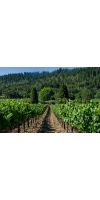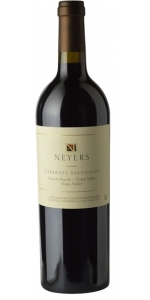Wine from Neyers

About 25% of our production is Merlot and Cabernet Sauvignon grown on our 50-acre, Conn Valley ranch. We purchase additional grapes from a select group of growers, among them the Sangiacomo family of the Carneros District, Will Nord of Napa, the Rossi Ranch of Sonoma County, Markus Bokisch and the Evangelho family.
Neyers Vineyards sits in the heart of the Napa Valley but Bruce’s experience with French wine importer Kermit Lynch has had an undeniable influence on our wines. Many of the French producers Bruce works with farm organically, make their wines naturally without use of cultured yeast or laboratory designed malo-lactic starter, and bottle their wines without fining or filtration. We like their results and utilize many of their ideas.
Our barrels are made in France, to our specifications, from wood that we buy in bulk and air dry for three years, two years longer than normal. All of our grapes are picked by hand, into small bins that hold only one-half ton. They are then laboriously hand sorted and inspected at the winery. Grapes that require travel of more than thirty minutes to our winery are delivered in refrigerated trucks.
Our wines are aged with as little intervention as possible, and in most years we bottle our wines with neither fining nor filtration, using a state of the art mobile bottling line. No expense has been spared in our grape growing, winemaking practices, or processing equipment, yet customers repeatedly tell us that our wines represent great value in today’s highly competitive wine market.
Neyers Cabernet Sauvignon Neyers Ranch is made from 100 percent Cabernet Sauvignon.
"We harvested the 2017 Cabernet Sauvignon crop from our Conn Valley Ranch in the first week of October, a week later than we picked the same vineyard the prior year. The size of the crop was about 20% smaller in 2017 as well, mostly due to the cold, wet weather we experienced in spring during flowering. Grapevines are self-pollinating, and cold, windy or damp weather interferes with this process, a problem known the French call coulure. Ironically, the harsh spring weather of 2017 had a huge impact on the size of our crop. Still, this smaller crop ripened fully and evenly, and at harvest time we picked beautiful, dark-colored clusters under near-perfect conditions. The finished wine was immediately remarkable for its flavor and complexity, and the wine looks to be one that will improve for many years. During my career in the Napa Valley wine business, I’ve learned to expect the best wines from cold years like 2017. These are vintages that are viewed initially with lowered expectations, but my experience has been just the opposite. Going back to my first Napa Valley harvest in 1971, these ‘colder years’ invariably result in wines with brighter, more attractive flavors, and the wines age longer and more gracefully.
Following harvest, the wine was fermented using wild, native yeast in an temperature-controlled stainless steel tank. After 45 days or so, the tank was drained and the pomace pressed, and the wine transferred to 60-gallon French oak barrels, 25% of them new. During the first year, we racked the wine off of the yeast lees three times, and by May 2019 it had been sufficiently clarified to bottle without fining or filtration. I am especially impressed by its bright ruby hue, a color so commanding it reminded me of the 1995 red Bordeaux wines I tasted from barrel during my trip to France in the Spring of 1996. It’s loaded with flavors that range from wild cherry to chocolate, enhanced by the lovely hint of tobacco leaf and mint. Each aromatic component has its own individual fascination, but all of them together provide a remarkable experience. Here’s a complete Napa Valley Cabernet Sauvignon that we expect it to improve for 20 years. It's a from a very small crop that will provide decades of pleasure." - Bruce Neyers
Review:
Earthy, tannic and young, this wine brims in black fruit, cedar and tobacco that are accented by black olive and crushed rock. With substantial midpalate weight, it takes time to integrate, finding a cohesive conclusion on the long finish.
-Wine Enthusiast 92 Points
- back
Selected Options
Wineries
Categories
Pricing
Countries
Regions
Grape Types
Wineries
Organic/Free Shipping
Belle Glos Las Alturas Vineyard Pinot Noir is made from 100 percent Pinot Noir.
Deep garnet in color with an aromatic medley of black cherry, marionberry, ripe plum and a hint of anise. Dark fruit on the palate with flavors of wild berries, caramelized oak and cacao nibs complemented by subtle notes of vanilla, cedar and a hint of lavender and forest floor. Rich and unrestrained, this wine’s abundant fruit is beautifully balanced by firm acidity and layers of red and black fruit.
Review:
Deep and dark aromas of black cherry, sandalwood and incense make for a heady nose on this bottling. The palate is big and bold, loaded with ripe black cherry and boysenberry flavors, as peppery, incense-like spices add complexity and the texture stays lusciously creamy.
-Wine Enthusiast 93 Points
Domaine de la Janasse Chateauneuf-du-Pape Cuvee Vieilles Vignes is made from 65% Grenache, 20% Mourvèdre, 10% Syrah, 5% divers.
In contrast to Chaupin, which is made from old-vine Grenache on sandy soils, the cuvée Vieilles Vignes is from old vines of Grenache, Mourvedre, Syrah along with smaller percentages of other permitted varieties that are grown in these old vineyards. The wine is sourced from 4 terroirs: pebbly clay, sand, gravelly red clay and sandy limestone. Vieilles Vignes is always the most powerful and concentrated Châteauneuf-du-Pape cuvée made at Domaine de la Janasse.
Review:
The advantages of old vines are perhaps most evident in the more difficult vintages (whether hot and dry or cool and rainy). The 2021 Chateauneuf du Pape Vieilles Vignes is a strong effort, delivering supple, velvety waves of ripe black cherries and black raspberries. Medium to full-bodied, it's rich and concentrated without seeming at all heavy or unbalanced, finishing long and juicy. It's approximately 75% Grenache, 15% Mourvèdre, 5% Syrah and 5% other varieties, keeping in mind that up to 15% of the old Grenache vines are actually Clairette Rose.
-Wine Advocate 96 Points





